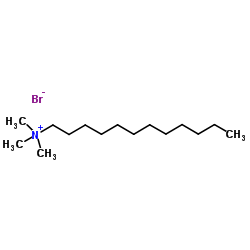DTAB

DTAB structure
|
Common Name | DTAB | ||
|---|---|---|---|---|
| CAS Number | 1119-94-4 | Molecular Weight | 308.341 | |
| Density | N/A | Boiling Point | N/A | |
| Molecular Formula | C15H34BrN | Melting Point | 246 °C (dec.)(lit.) | |
| MSDS | Chinese USA | Flash Point | 246°C | |
| Symbol |


GHS07, GHS09 |
Signal Word | Warning | |
|
Probing competitive interactions in quaternary formulations.
J. Colloid. Interface Sci. 454 , 35-43, (2015) The interaction of amphiphilic block copolymers of the poly(ethylene oxide)-poly(propylene oxide)-poly(ethylene oxide) (PEO-PPO-PEO) group with small molecule surfactants may be "tuned" by the presence of selected alcohols, with strong interactions leading to... |
|
|
Salt effect on microscopic structure and stability of colloidal complex obtained from neutral/polyelectrolyte block copolymer and oppositely charged surfactant.
Colloids Surf. B Biointerfaces 99 , 127-35, (2012) The salt effect on complex formation of poly(acrylamide)-block-poly(acrylic acid) (PAM-b-PAA) and dodecyltrimethylammonium bromide (DTAB) at different NaBr concentrations, C(NaBr), was investigated by laser light scattering (LLS) and small angle neutron scatt... |
|
|
Analysis of plasma nucleotides in rat by micellar electrokinetic capillary chromatography/electrospray ionization mass spectrometry.
Rapid Commun. Mass Spectrom. 26(12) , 1426-36, (2012) The aim of this study was to establish a simultaneous quantitative analysis method of nine endogenous nucleotides in rat plasma using micellar electrokinetic capillary chromatography/electrospray ionization mass spectrometry (MEKC/ESI-MS).To select the optimu... |
|
|
Correlating structure and photocurrent for composite semiconducting nanoparticles with contrast variation small-angle neutron scattering and photoconductive atomic force microscopy.
ACS Nano 8(5) , 4313-24, (2014) Aqueous dispersions of semiconducting nanoparticles have shown promise as a robust and scalable platform for the production of efficient polymer/fullerene active layers in organic photovoltaic applications. Semiconducting nanoparticles are a composite of both... |
|
|
Bicephalic amphiphile architecture affects antibacterial activity.
Eur. J. Med. Chem. 46 , 4219-26, (2011) A series of cationic amphiphiles, each with an aromatic core, was prepared and investigated for antimicrobial properties. The synthesized amphiphiles in this study are bicephalic (double-headed) in that they each possess two trimethylammonium head groups and ... |
|
|
Mixtures of catanionic surfactants can be superspreaders: Comparison with trisiloxane superspreader.
J. Colloid. Interface Sci. 459 , 250-6, (2015) Mixed solutions of cationic and anionic surfactants show considerable synergism in their wetting behaviour, but their spreading is affected considerably by the phase separation processes. The valuable information about wetting properties of synergetic mixture... |
|
|
Solubilization of two organic dyes by cationic ester-containing gemini surfactants.
J. Colloid. Interface Sci. 376(1) , 112-8, (2012) Solubilization of two different types of organic dyes, Quinizarin with an anthraquinone structure and Sudan I with an azo structure, has been studied in aqueous solutions of a series of cationic gemini surfactants and of a conventional monomeric cationic surf... |
|
|
Self-nanoemulsifying drug delivery systems as novel approach for pDNA drug delivery.
Int. J. Pharm. 487 , 25-31, (2015) It was the aim of this study to investigate a novel strategy for oral gene delivery utilizing a self-nanoemulsifying drug delivery system (SNEDDS). After hydrophobic ion pairing a plasmid was incorporated into SNEDDS. The mean droplet size of resulting nanoem... |
|
|
Competition of hydrophobic steroids with sodium dodecyl sulfate, dodecyltrimethylammonium bromide, or dodecyl β-D-maltoside for the dodecane/water interface.
Langmuir 28(49) , 16927-32, (2012) The surface tension lowering abilities of insoluble steroids, progesterone and testosterone, were examined at the dodecane/water interface in the presence and absence of surfactants, sodium dodecyl sulfate, dodecyltrimethylammonium bromide, and dodecyl maltos... |
|
|
Nanocomposite formation between alpha-glucosyl stevia and surfactant improves the dissolution profile of poorly water-soluble drug.
Int. J. Pharm. 428(1-2) , 183-6, (2012) The formation of a hybrid-nanocomposite using α-glucosyl stevia (Stevia-G) and surfactant was explored to improve the dissolution of flurbiprofen (FP). As reported previously, the dissolution amount of FP was enhanced in the presence of Stevia-G, induced by t... |